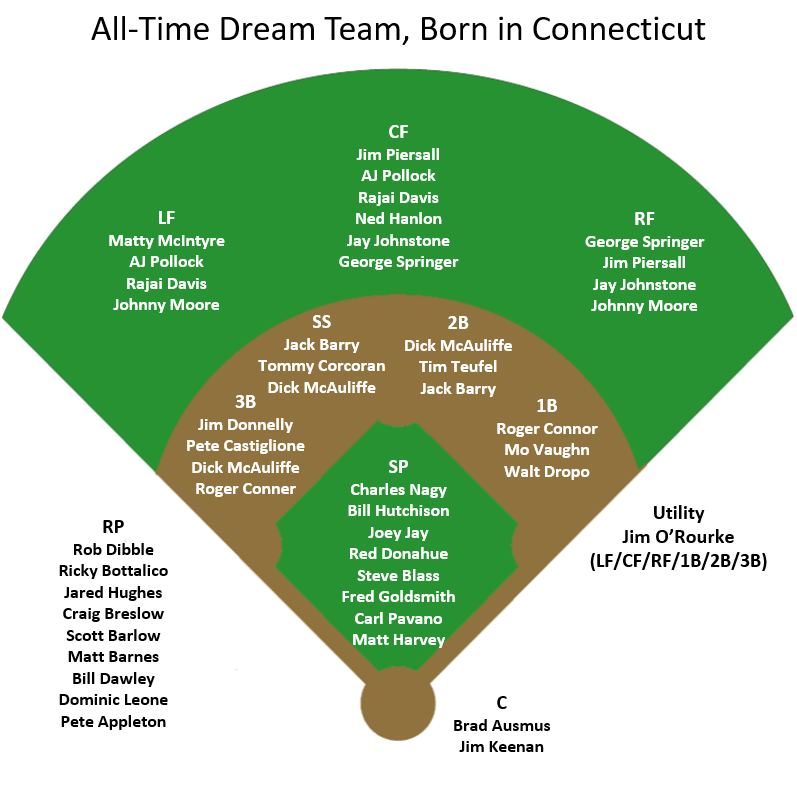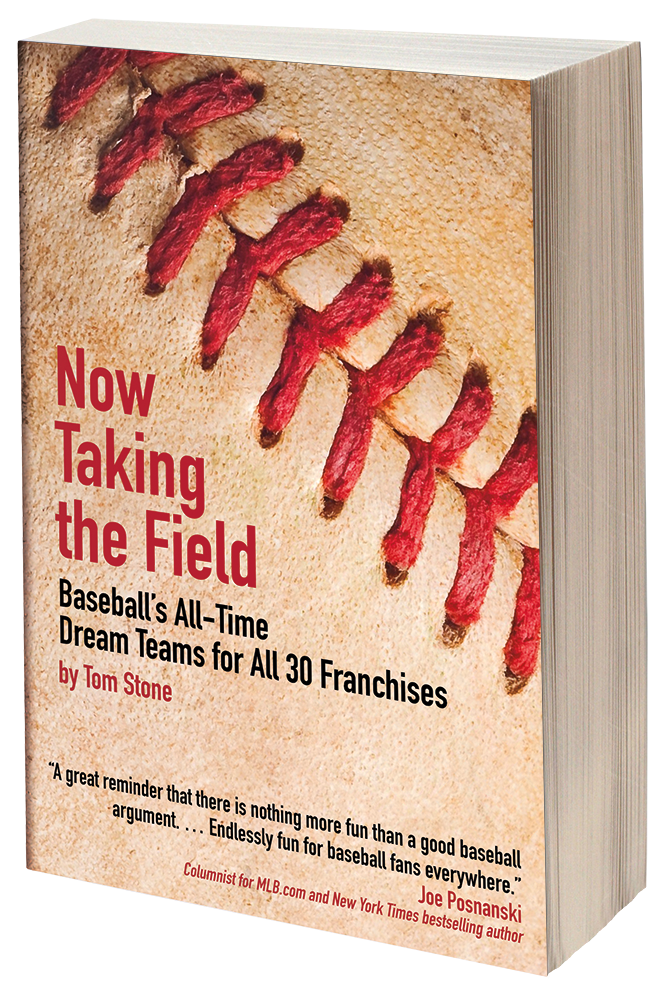Connecticut's Baseball All-Time Dream Team
What would a dream team roster look like for major league players born in Connecticut?
Issue #155
This is the 39th article in a series where I am creating all-time dream teams for players born in each of the fifty US states. I’m publishing each write-up on the anniversary date that the particular state joined the union. So far I’ve covered Maryland, Louisiana, Minnesota, South Carolina, Rhode Island, Wisconsin, Kentucky, Tennessee, Arkansas, West Virginia, New Hampshire, Virginia, Idaho, Wyoming, New York, Colorado, Missouri, Hawaii, California, Nevada, North and South Dakota, Montana, Washington, Oklahoma, North Carolina, Illinois, Delaware, Mississippi, Indiana, Pennsylvania, Alabama, New Jersey, Iowa, Texas, Georgia, Alaska, Utah, and New Mexico.
Next up is Connecticut, which became the fifth state to join the union on January 9th, 1788 (according to Wikipedia).
Important caveat to what follows: I’m creating these all-time dream teams based on the birthplace data available at baseball-reference.com. I realize this might mean some players will appear for a state’s all-time dream that seems odd, e.g., a player who was born in one state but lived there only briefly, while then spending most of his youth, or especially critical years playing baseball in high school in another state. So that is an important caveat to the below dream team roster—and I’ll discuss the players that I know went to high school in a state other than Connecticut towards the end of this article (and vice-versa, those born elsewhere but who went to high school in Connecticut.)
Here is the all-time dream team I came up with for players born in Connecticut:
Not being a huge state, my expectations for Connecticut’s dream team were modest. And sure enough, I found a mix of some star players and some relatively weaker positions. That said, there are three Hall of Famers on this roster—all of them old-timers:
Roger Connor was a 1B who played from 1880-1897, and topped 100+ runs eight times and 100+ RBI four times. He led the NL with a .371 average in 1885, and retired with a .316/.397/.486 slash line and 153 OPS+.
Jim O’Rourke played from 1872-1893 and for several seasons was a teammate of Connor’s on the New York Giants. He played all over the diamond, putting in significant time at all three OF positions, as well as 1B, 2B, 3B—and even serving as a player-manager for several seasons. He scored 100+ runs five times, and retired with a .310/.352/.422 slash line and 134 OPS+.
Ned Hanlon was elected to the Hall of Fame primarily as a manager, as he managed in 20 major league seasons including five times winning the NL pennant. But he also was a capable player for 13 major league seasons, with quite a bit of speed as the data available for the second half of his playing career indicates five seasons of 50+ SB. Beyond that skill he was a league-average hitter, with a .259/.324/.339 slash line and 102 OPS+.
Other star names amongst the position players include RF/CF George Springer, CF/RF Jimmy Piersall, and 1B Mo Vaughn and Walt Dropo. Catcher Brad Ausmus was not a big hitter, but won three Gold Glove Awards during his 18-year career. And 2B/3B/SS Dick McAuliffe was a three-time All-Star for the Tigers.
Starting lineups for this all-time dream team could look like this:
Against RHP:
George Springer (R) RF
Jim O'Rourke (R) LF
Roger Connor (S) 1B
Mo Vaughn (L) DH
Dick McAuliffe (L) 2B
Jim Piersall / AJ Pollock (R) CF
Jack Barry (R) SS
Brad Ausmus (R) C
Jim Donnelly / Pete Castiglione (R) 3B
Against LHP:
George Springer (R) RF
Jim O'Rourke (R) LF
Roger Connor (S) 1B
Walt Dropo (R) DH
Jim Piersall / AJ Pollock (R) CF
Tim Teufel (R) 2B
Jack Barry (R) SS
Brad Ausmus (R) C
Jim Donnelly / Pete Castiglione (R) 3B
The first three seemed pretty clear-cut with Springer and old-timers O’Rourke and Connor. For the clean-up spot DH spot I went with a platoon of power hitters in Mo Vaughn and Walt Dropo. Both Piersall and Pollock hit right-handed, so they can share the duties in CF, and ditto for the light-hitting 3B options with Jim Donnelly and Pete Castiglione.
Besides DH, the other platoon option arose at 2B where Dick McAuliffe had extreme splits in not hitting LHP very well at all. So Tim Teufel, who was often a platoon player during his career anyway, would be a good partner.
As for the pitching staff, there is no clear ace starter. I went with three-time All-Star Charles Nagy (1990-2003) who had 15+ wins in six seasons, though retired with a 4.51 ERA and 101 ERA+. Another candidate would be old-timer Bill Hutchison, who pitched in the majors a little in 1884 and a little in 1897, but was a regular from 1889-1895. He was a workhorse who impressively led the NL in wins each year from 1890-1892, with records of 41-25, 44-19, and 36-36. He also led the NL in GS, CG, and IP each of those years as well, and overall had a 3.59 ERA and 112 ERA+ for his career.
How you rank the other starters I included on this roster could also be debated. Joey Jay was an All-Star for the Reds in 1961, the first of two consecutive 21-win seasons, but only won 10 or more games one other time in his career and retired with a 3.77 ERA and 99 ERA+. Similarly, Red Donahue had a 3.61 ERA and 96 ERA+ for his career (1893, 1895-1906), but had some good seasons and won 20+ games three times. And Steve Blass pitched all 10 of his Major League seasons for the Pirates, was an All-Star in 1972 when he went 19-8 with a 2.49 ERA, and also posted a 2.12 ERA and 18-6 record in 1968.
The bullpen on this dream team is led by one of the Reds’ Nasty Boys in Rob Dibble, who piled up a lot of strikeouts and had a 1.90 ERA in his first three seasons (1988-1990), and later retired with a 2.98 ERA and 129 ERA+ overall. Ricky Bottalico pitched for seven different teams, but spent most of his best years with the Phillies, including consecutive 34-save seasons in 1996-97. Three current relievers are also included in the bullpen here: Scott Barlow, Matt Barnes, and Dominic Leone.
Lastly, I wasn’t very familiar with Pete Appleton, but he seems to be the very definition of a journeyman pitcher. Starting out at the age of 23 for Cincinnati in 1927, he would go on to pitch for seven franchises across 14 major league seasons through 1945. He pitched in a total of 341 games, with 73 starts and a cumulative 4.30 ERA and 104 ERA+. And he then continued on a bit longer still, pitching in the minors until he was 47.
What about players who went to High School in Connecticut?
As noted at the outset of this article, and as I’ve done for my other US State dream team write-ups, what if you change the criteria from players who were born in the state of Connecticut to players who grew up—which we’ll define as going to high school—in the state of Connecticut?
First off, some of the players on the roster above were born in Connecticut but went to high school elsewhere, including:
1B Mo Vaughn – New York
LF Matty McIntyre – New York
RF/CF Jay Johnstone – California
RP Jared Hughes – California
RP Scott Barlow – California
On the other hand, I also found several who were born elsewhere but went to high school in the state of Connecticut:
1B Jeff Bagwell – Massachusetts
3B/SS Joe Dugan – Pennsylvania
SP Charlie Morton – New Jersey
RP/SP Moe Drabowsky – Poland
So using this alternate dream team criterion, these players would all be included on a Connecticut dream team. Bagwell would more than replace Vaughn and serve as the 1B or DH. Dugan would also slot in as the starting 3B, as he was a somewhat better hitter than Donnelly or Castiglione. Morton would compete for a spot in this dream’s team five-man rotation, and Drabowsky could be used in either relief or starting roles, and would take the other spot vacated by Hughes and Barlow.
All data is from Baseball-Reference.com, and also their subscription service Stathead.com. If you are a big sports fan, be sure to check out the latest features at Stathead and the Sports Reference family of sites. The state map, flag, flower, and bird images are from Wikipedia.
Did you know? I wrote a book with the same title as this Substack newsletter / blog: Now Taking the Field: Baseball’s All-Time Dream Teams for All 30 Franchises. It was published in early 2019, by ACTA Sports, the publisher of the annual Bill James Handbook and other popular titles. You can learn more about it at www.NowTakingTheField.com, or buy directly at Amazon and other booksellers.






